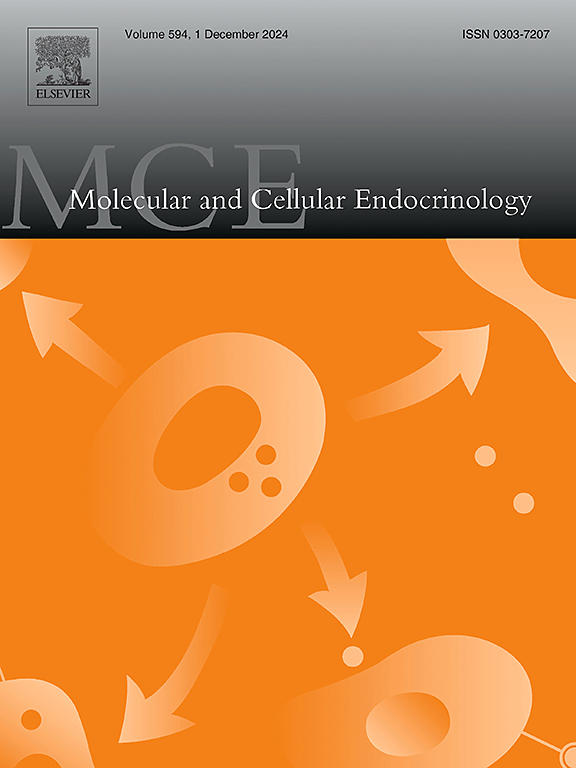Bone action of the phytoestrogen genistein under hypoestrogenism and obesity
IF 3.8
3区 医学
Q2 CELL BIOLOGY
引用次数: 0
Abstract
Osteoporosis and obesity are prevalent diseases in menopause. The phytoestrogen genistein (Gen) is an antioxidant/anti-inflammatory agent proposed as natural therapy to counteract syndromes associated to menopause. In this work we evaluated the bone effect of Gen in a stress environment induced by hypoestrogenism and obesity. Bilaterally ovariectomized female Wistar rats were fed with high-fat diet (obese), or standard diet (non-obese). Osteoblasts (OB) primary cultures from femoral shafts, and retroperitoneal explants of white adipose tissue (WAT) in vitro exposed to Gen were employed as experimental systems. In obese rats, bone oxidative stress revealed by enhancement on H2O2 release, and significant reduction in OB nitric oxide (NO) production, cell growth, alkaline phosphatase activity (ALP), matrix mineralization and collagen deposition was detected. In OB-WAT co-cultures, Gen treatment inhibited H2O2 secretion, and prompted OB differentiation. A direct action of Gen on WAT was demonstrated. The phytoestrogen inhibited H2O2 and TBARS production, and diminished the secretion of the inflammatory adipokine leptin, through a mechanism of action mediated by estrogen receptor (ER) involvement, and MAPK and PI3K signal transduction pathways participation. A directional interaction from WAT to bone was evidenced by the incubation OB with conditioned medium obtained from WAT exposed to Gen (Gen-CM). The presence of Gen-CM improved OB growth, and reduced H2O2 production. The antioxidative effect of Gen on obese bone cells was partially dependent on its ability to reduce leptin secretion by WAT. Altogether, the results suggest that, under obesity, Gen may improve bone metabolism through a direct action on WAT.
植物雌激素染料木素在雌激素过低和肥胖情况下对骨骼的作用。
骨质疏松症和肥胖症是更年期的常见疾病。植物雌激素染料木素(Gen)是一种抗氧化/抗炎剂,被建议作为对抗更年期相关综合症的自然疗法。在这项研究中,我们评估了 Gen 在雌激素过低和肥胖所导致的压力环境中对骨骼的影响。用高脂肪饮食(肥胖)或标准饮食(非肥胖)喂养双侧卵巢切除的雌性 Wistar 大鼠。实验系统采用了来自股骨柄的成骨细胞(OB)原代培养物和体外暴露于 Gen 的腹膜后白色脂肪组织(WAT)外植体。在肥胖大鼠体内,骨氧化应激表现为 H2O2 释放增加,OB 一氧化氮(NO)产生、细胞生长、碱性磷酸酶活性(ALP)、基质矿化和胶原沉积显著减少。在 OB-WAT 共培养中,Gen 处理抑制了 H2O2 的分泌,并促进了 OB 的分化。结果表明,Gen 可直接作用于 WAT。通过雌激素受体(ER)参与、MAPK 和 PI3K 信号转导途径参与的作用机制,植物雌激素抑制了 H2O2 和 TBARS 的产生,并减少了炎症性脂肪因子瘦素的分泌。用暴露于 Gen(Gen-CM)的 WAT 获得的条件培养基培养 OB,证明了从 WAT 到骨骼的定向相互作用。Gen-CM的存在改善了OB的生长,并减少了H2O2的产生。Gen 对肥胖骨细胞的抗氧化作用部分取决于其减少 WAT 分泌瘦素的能力。总之,研究结果表明,在肥胖的情况下,Gen 可通过直接作用于 WAT 来改善骨代谢。
本文章由计算机程序翻译,如有差异,请以英文原文为准。
求助全文
约1分钟内获得全文
求助全文
来源期刊

Molecular and Cellular Endocrinology
医学-内分泌学与代谢
CiteScore
9.00
自引率
2.40%
发文量
174
审稿时长
42 days
期刊介绍:
Molecular and Cellular Endocrinology was established in 1974 to meet the demand for integrated publication on all aspects related to the genetic and biochemical effects, synthesis and secretions of extracellular signals (hormones, neurotransmitters, etc.) and to the understanding of cellular regulatory mechanisms involved in hormonal control.
 求助内容:
求助内容: 应助结果提醒方式:
应助结果提醒方式:


